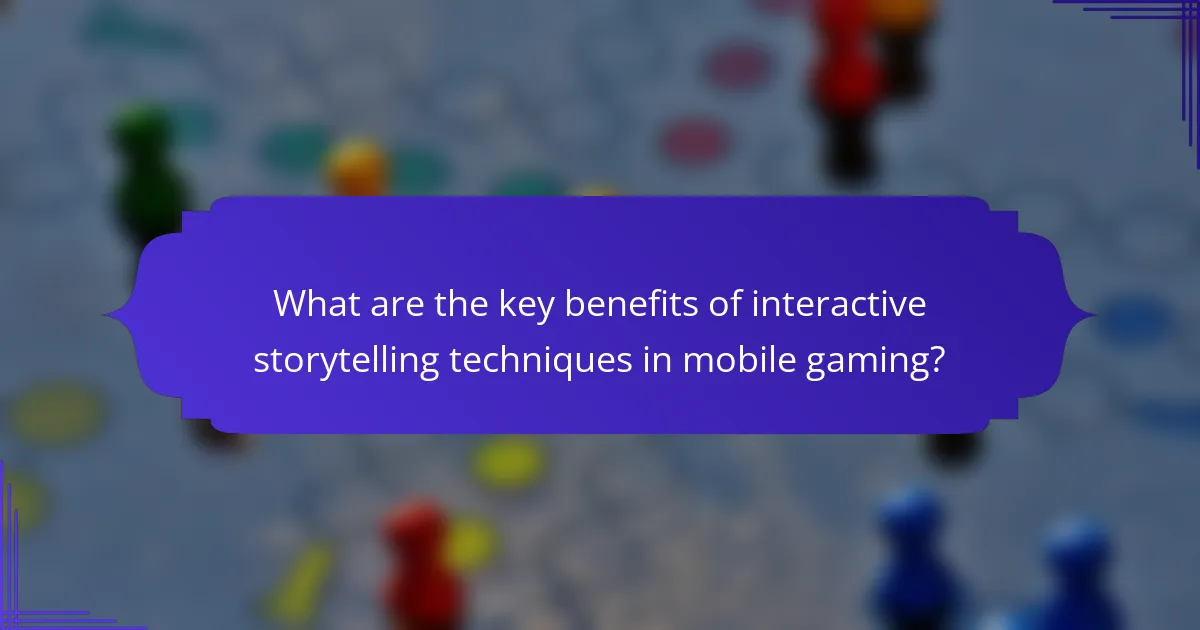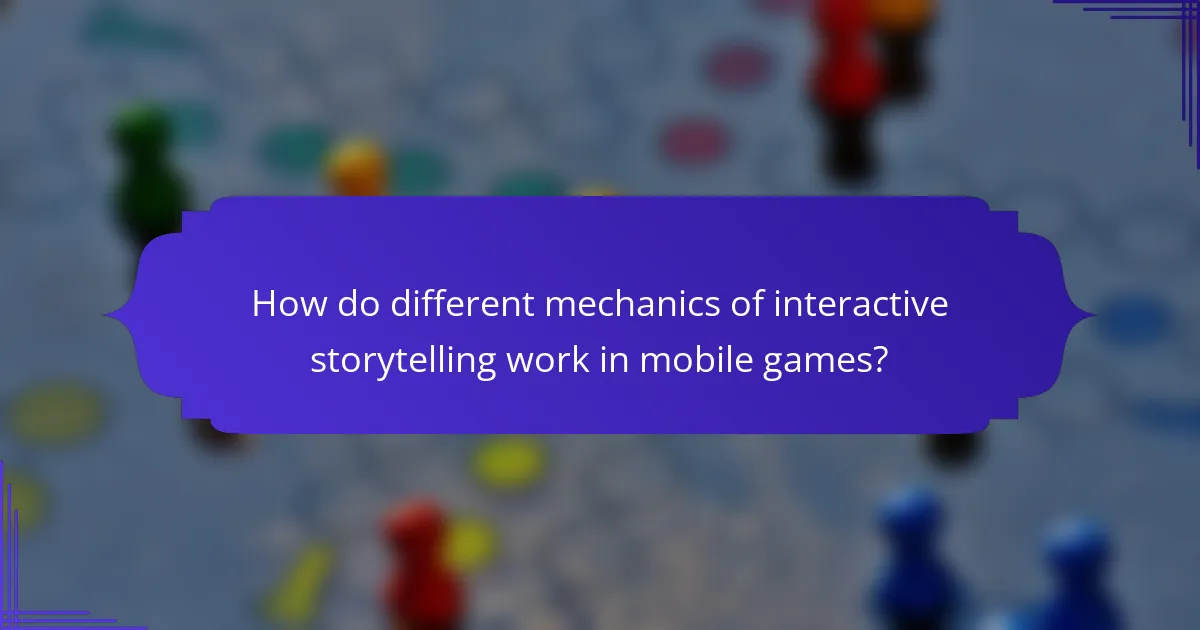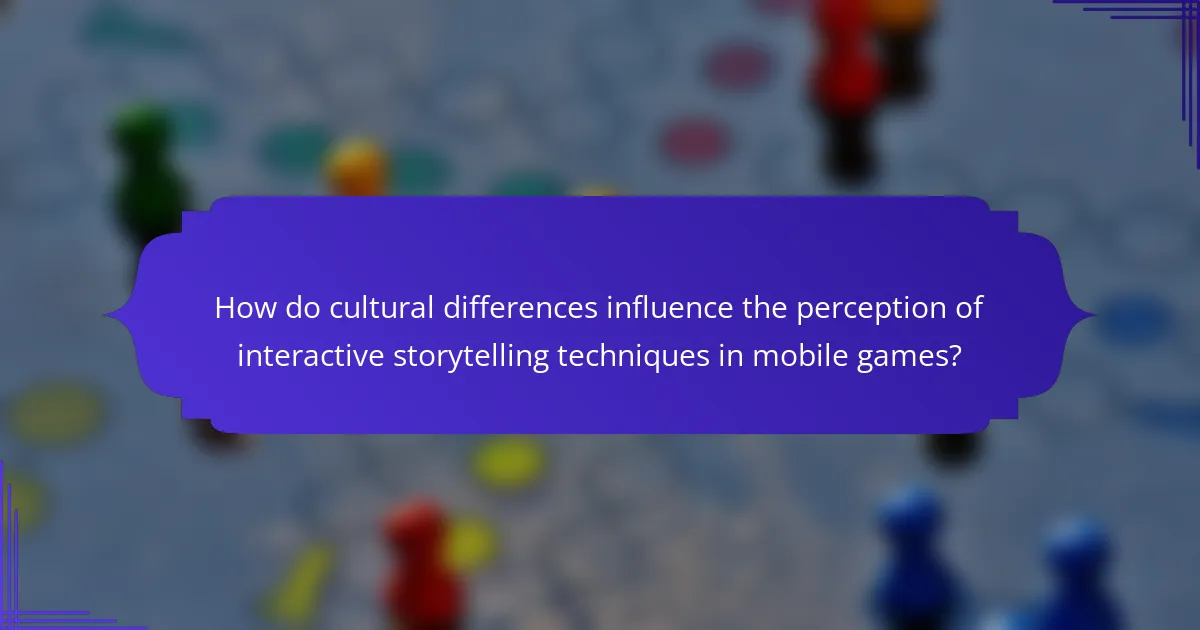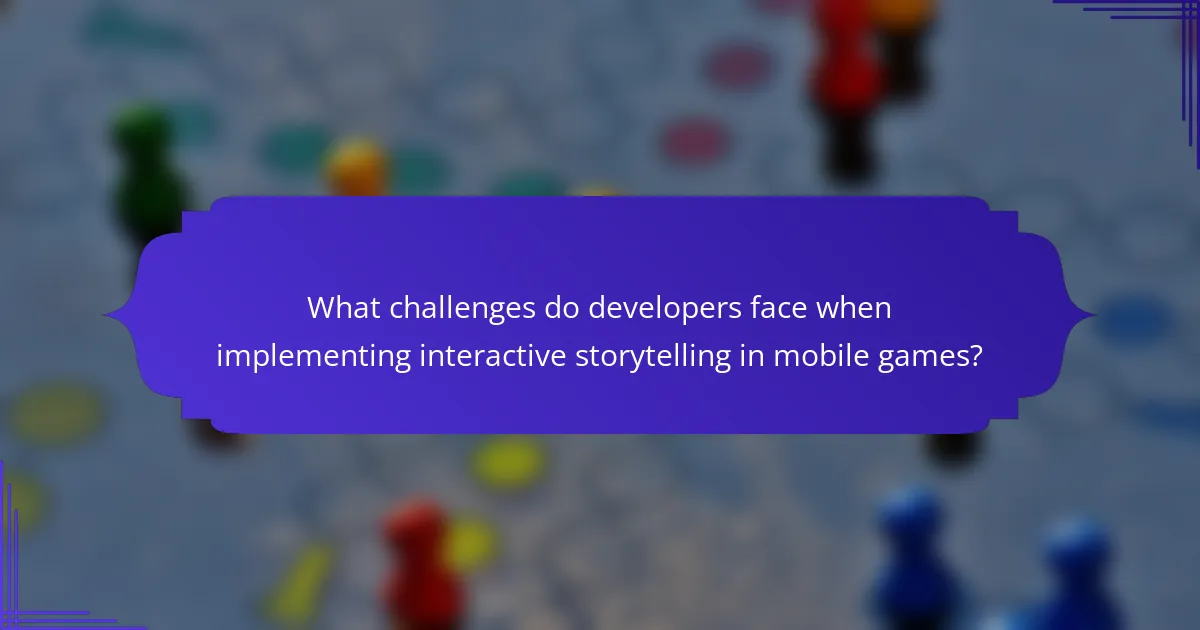Interactive storytelling techniques in mobile gaming significantly enhance player engagement and emotional connection. This article explores the benefits of these techniques, examines the mechanics like branching narratives and character development, and highlights successful examples such as “Life is Strange” and “The Walking Dead.” Additionally, it addresses cultural influences on storytelling and the challenges developers face in creating immersive experiences. Finally, emerging trends in interactive storytelling will be discussed, focusing on innovations like AI-driven narratives and user-generated content.

What are the key benefits of interactive storytelling techniques in mobile gaming?
Interactive storytelling techniques in mobile gaming enhance player engagement, emotional connection, and replayability. These techniques allow players to make choices that influence the narrative, creating a personalized experience. As a result, players feel more invested in the outcome, leading to increased satisfaction and immersion. Furthermore, these techniques can foster community interaction, as players share different story paths and outcomes, enriching the gaming experience.
How do interactive storytelling techniques enhance player engagement?
Interactive storytelling techniques significantly enhance player engagement by creating immersive experiences. These techniques foster emotional connections, allowing players to influence narratives directly, which increases investment in the game. Dynamic choices and branching storylines adapt to player actions, ensuring unique experiences that maintain interest over time. For example, games like “Life is Strange” utilize these methods effectively, encouraging players to explore different outcomes based on their decisions. This interactivity not only deepens immersion but also promotes replayability, as players seek to uncover all narrative possibilities.
Which emotional responses do these techniques evoke in players?
Interactive storytelling techniques in mobile gaming evoke a range of emotional responses in players, including excitement, empathy, and tension. These techniques enhance player immersion, making them feel more connected to characters and narratives. As a result, players often experience heightened emotional engagement, leading to memorable gaming moments. The use of branching narratives can create suspense and anticipation, while character development fosters empathy, allowing players to relate to their experiences.
What impact do interactive storytelling techniques have on player retention rates?
Interactive storytelling techniques significantly enhance player retention rates by fostering emotional connections. These techniques include branching narratives, character development, and player choice, which create immersive experiences. As a result, players are more likely to engage consistently with the game. Studies show that games utilizing interactive storytelling can increase retention rates by up to 30%. This engagement is driven by the unique attribute of personalized experiences that adapt to player decisions, making each playthrough distinct and compelling.

How do different mechanics of interactive storytelling work in mobile games?
Interactive storytelling in mobile games employs mechanics like branching narratives, player choices, and character development to engage users. These techniques enhance immersion and emotional investment, making the gaming experience more dynamic.
Branching narratives allow players to make decisions that affect the storyline. For example, choosing different dialogue options can lead to multiple endings, increasing replayability. Player choices create a sense of agency, allowing users to shape their journey.
Character development is crucial in interactive storytelling. Players connect with characters through backstories and evolving relationships, enhancing emotional stakes. This connection drives players to invest more time and effort into the game.
Examples of successful interactive storytelling include games like “Life is Strange,” which uses choices to impact the narrative significantly, and “The Walking Dead,” where character decisions lead to lasting consequences. These games showcase the effectiveness of interactive mechanics in enhancing player engagement.
What role does player choice play in interactive narratives?
Player choice significantly enhances interactive narratives by fostering engagement and emotional investment. It allows players to shape their story experience, influencing outcomes and character development. This interactivity creates a personalized journey, making choices feel impactful. As a result, players are more likely to connect with the narrative, enhancing replayability and satisfaction.
How can branching storylines affect gameplay experience?
Branching storylines significantly enhance gameplay experience by providing players with unique choices and outcomes. This interactivity fosters deeper engagement and emotional investment. Players feel their decisions matter, leading to varied narratives that can change the game’s direction. As a result, replayability increases, as players explore different paths and endings. This technique also allows for personalized experiences, catering to diverse player preferences and play styles.
What are the different forms of narrative delivery in mobile gaming?
Mobile games utilize various narrative delivery forms to engage players. Key techniques include branching narratives, where player choices shape the story’s direction, and episodic storytelling, which unfolds the plot over multiple segments. Other forms are environmental storytelling, where the game world conveys narrative through design, and dialogue trees, allowing players to interact with characters through selectable responses. These methods enhance immersion and emotional connection, enriching the gaming experience.

Which successful examples illustrate effective interactive storytelling in mobile gaming?
Effective interactive storytelling in mobile gaming is exemplified by titles like “Life is Strange,” “The Walking Dead,” and “Choice of the Dragon.” These games utilize player choices to shape narratives, enhancing engagement and emotional investment. “Life is Strange” features time manipulation, allowing players to revisit decisions, while “The Walking Dead” focuses on moral dilemmas that affect character relationships. “Choice of the Dragon” offers a unique text-based format, emphasizing player agency through choices that directly influence the story’s outcome.
What can be learned from narrative-driven games like “Life is Strange”?
Narrative-driven games like “Life is Strange” teach valuable lessons about emotional engagement and decision-making. Players explore complex characters and moral dilemmas, enhancing empathy and critical thinking skills. These games utilize branching storylines that respond to player choices, demonstrating the impact of actions and fostering a sense of agency. As a result, players experience a deeper connection to the narrative, leading to memorable and impactful gaming experiences.
How does “80 Days” utilize interactive storytelling to engage players?
“80 Days” utilizes interactive storytelling by allowing players to make choices that directly influence the game’s narrative and outcomes. This approach enhances player engagement by creating a personalized experience. Key techniques include branching storylines, dynamic character interactions, and time-sensitive decisions, which collectively immerse players in a rich, evolving world. The game’s unique attribute lies in its ability to blend exploration with storytelling, as players navigate diverse cultures and scenarios, enhancing the overall experience. This method not only captivates players but also encourages replayability, as different choices lead to varied endings and adventures.
What innovative approaches are seen in “The Walking Dead” mobile game?
“The Walking Dead” mobile game employs innovative interactive storytelling techniques that enhance player engagement. These techniques include branching narratives, where player choices significantly impact story outcomes, creating a personalized experience. Additionally, the game utilizes character development through emotional connections, allowing players to form attachments that influence decisions. Real-time decision-making mechanics heighten tension and immersion, making players feel the weight of their choices. Finally, episodic content keeps the narrative fresh and encourages ongoing player investment in the evolving story.

How do cultural differences influence the perception of interactive storytelling techniques in mobile games?
Cultural differences significantly shape how players perceive interactive storytelling techniques in mobile games. These techniques often reflect cultural narratives, values, and communication styles, influencing engagement.
Cultural contexts affect player expectations. For instance, Eastern cultures may favor collective storytelling, while Western cultures often emphasize individual heroism. This influences narrative structures and character development.
Localization plays a crucial role. Adapting stories to resonate with local customs enhances relatability. Games that incorporate cultural references or folklore can improve player immersion and emotional connection.
Player feedback varies across cultures. Some cultures may prioritize gameplay mechanics over narrative depth, while others may seek rich storytelling. Understanding these preferences can inform game design and marketing strategies.
What storytelling elements resonate more with players in different regions?
Interactive storytelling elements that resonate with players vary by region. Cultural narratives, character development, and emotional engagement are crucial across markets. For instance, Asian players often favor intricate plots and character arcs, while Western audiences may prefer straightforward narratives with clear objectives. Regional folklore can enhance connection and immersion, making localized content more appealing. Additionally, gameplay mechanics that encourage player choice and agency are universally appreciated, fostering deeper investment in the story.
How does local culture shape narrative preferences in mobile gaming?
Local culture significantly influences narrative preferences in mobile gaming by shaping themes, character development, and storytelling styles. Players often connect more deeply with narratives that reflect their cultural values and experiences. For example, games featuring local folklore or historical events resonate strongly with regional audiences. This cultural alignment enhances player engagement and satisfaction, leading to a more immersive gaming experience. Additionally, local language use and culturally relevant humor can further personalize the narrative, making it more appealing to diverse audiences.

What challenges do developers face when implementing interactive storytelling in mobile games?
Developers face several challenges when implementing interactive storytelling in mobile games, including limited screen space, balancing narrative depth with gameplay, and ensuring player agency. Limited screen space restricts the amount of text and visuals that can be presented, making it difficult to convey complex narratives. Balancing narrative depth with gameplay mechanics is crucial; developers must ensure that the story enhances rather than detracts from the gaming experience. Additionally, providing meaningful player choices that impact the story can be challenging, as it requires extensive branching narratives and careful design to maintain coherence. Lastly, technical limitations of mobile devices can hinder the integration of advanced storytelling techniques, affecting overall user experience.
What are common pitfalls in designing interactive narratives?
Common pitfalls in designing interactive narratives include lack of player agency, convoluted storytelling, inconsistent character development, and poor pacing. These issues can frustrate players and detract from engagement.
1. Lack of player agency: When players feel their choices have no impact, it undermines the interactive experience.
2. Convoluted storytelling: Overly complex plots can confuse players, making it hard to follow the narrative.
3. Inconsistent character development: Characters that do not evolve or behave inconsistently can break immersion.
4. Poor pacing: A narrative that drags or rushes through key moments can lead to player dissatisfaction.
Addressing these pitfalls can enhance the effectiveness of interactive storytelling in mobile gaming.
How can developers balance storytelling with gameplay mechanics?
Developers can balance storytelling with gameplay mechanics by integrating narrative elements into core gameplay. This approach enhances player engagement while maintaining a seamless experience.
Effective techniques include using character-driven narratives that influence gameplay choices, creating branching storylines that respond to player actions, and employing environmental storytelling to enrich the game world. For instance, games like “Life is Strange” utilize player decisions to shape the story, blending mechanics with narrative depth.
Additionally, incorporating feedback loops where gameplay outcomes affect the narrative can deepen immersion. This balance ensures that players feel invested in both the story and the mechanics, leading to a more satisfying gaming experience.

What are the emerging trends in interactive storytelling for mobile gaming in 2025?
Emerging trends in interactive storytelling for mobile gaming in 2025 focus on immersive experiences, user-generated content, and AI-driven narratives. These advancements enhance player engagement and personalization.
1. Immersive Experiences: Augmented reality (AR) and virtual reality (VR) integration creates deeper connections between players and storylines.
2. User-Generated Content: Players can contribute to narratives, fostering community and enhancing replayability.
3. AI-Driven Narratives: Adaptive storytelling responds to player choices, ensuring unique experiences tailored to individual preferences.
4. Cross-Platform Storytelling: Seamless transitions between devices allow players to continue their stories anywhere, enhancing accessibility.
5. Multi-Sensory Engagement: Incorporating soundscapes and haptic feedback deepens emotional connections and immersion.
6. Ethical Storytelling: Developers focus on inclusive narratives that resonate with diverse audiences, promoting empathy and understanding.
How is technology shaping the future of interactive storytelling?
Technology is transforming interactive storytelling by enhancing player engagement and narrative depth. Advanced graphics, artificial intelligence, and real-time decision-making mechanics allow for personalized experiences. For instance, mobile games utilize branching narratives that adapt based on player choices, creating unique story arcs. This interactivity fosters emotional connections, making storytelling more immersive. Furthermore, augmented reality integrates real-world elements, enriching the narrative landscape. These innovations ensure that interactive storytelling evolves, offering richer and more dynamic experiences for players.
What new platforms are adopting interactive storytelling techniques?
Several new platforms are adopting interactive storytelling techniques in mobile gaming, enhancing user engagement. Notable examples include Netflix, which integrates interactive narratives in its mobile games, and Apple Arcade, featuring games that allow players to influence story outcomes. These platforms utilize branching storylines and player choices, fostering deeper immersion. Additionally, platforms like Roblox and Fortnite continue to innovate with user-generated content that emphasizes interactive storytelling, allowing players to create and share their narratives.
What are the best practices for optimizing interactive storytelling in mobile games?
To optimize interactive storytelling in mobile games, focus on user engagement, narrative depth, and seamless mechanics. Enhance player immersion by integrating choices that impact the storyline, creating a personal connection. Use varied pacing to maintain interest and incorporate visual and auditory elements to enrich the experience. Implement feedback loops that encourage player investment and adapt the narrative based on player actions, ensuring a dynamic storytelling approach.
